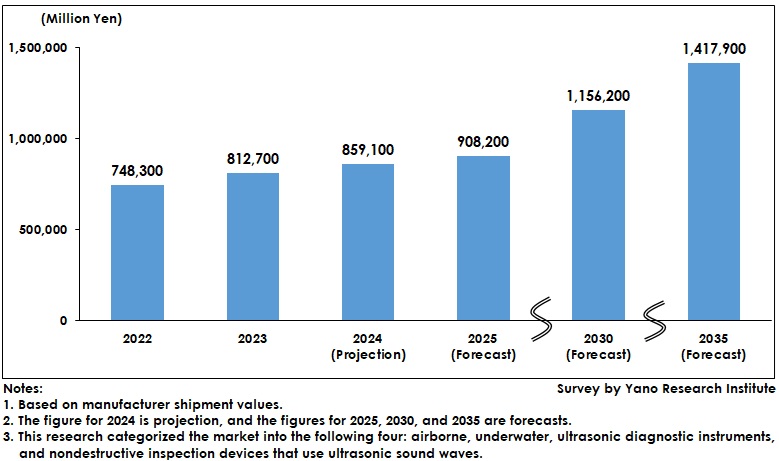No.3814
Global Ultrasonic Sensor Market: Key Research Findings 2025
Global Ultrasonic Sensor Market Expected to Reach 1,156.2 Billion Yen by 2030
Yano Research Institute (the President, Takashi Mizukoshi) surveyed the global market of industrial sensors and found out the trends by category and application, trends of market players, and the future outlook. In here focuses on the global market of ultrasonic sensors.

Market Overview
Because ultrasonic waves can efficiently extract high sound pressures and strong power densities from liquids and solid objects (but not from air), various products using them have been developed and practically used, such as ultrasound heaters/welders, ultrasonic wire bonders, and ultrasonic cleaners. Some have been developed for use in home appliances. While there is a diverse range of ultrasonic products, ultrasonic products fall into two categories: telecommunication applications, which use information signals of ultrasound waves, and dynamic applications of ultrasound, which use ultrasonic power and energy.
Currently, telecommunication applications are mainstream and are commonly used for distance measurement. Examples include fish finders and other underwater sonars, ultrasonic medical imaging diagnostics, ultrasonic flaw detectors, factory automation sensors, and automotive sensors.
This research calculated the market size of ultrasonic sensors used for distance measurement. Based on manufacturer shipment values, the global ultrasonic sensor market reached 812.7 billion yen in 2023, an 8.6% increase from the previous year.
Noteworthy Topics
History and Current Status of Automotive Ultrasonic Sensors
Airborne ultrasonic sensors have primarily been back sonar sensors ever since Toyota first installed them in 1982. It has been reported that cars equipped with these sensors reduce the occurrence of accidents compared to cars without them. Consequently, the number of automobiles with sensor installations, such as Toyota mounting a sonar at the front bumper and aligning it with an automatic braking system. These sensor-equipped cars evolved into those with parking assistance, which use ultrasonic sensors aligned with rear cameras to highly accurately detect obstacles and assist with parking maneuvers. These are examples of cars with ultrasonic sensors installed until around 2010.
Since the early 2010s, ultrasonic sensors have been installed in advanced driver-assistance systems (ADAS) and autonomous driving systems. While most ADAS and autonomous driving systems use monocular or compound-eye cameras (CMOS sensors), short- or long-range millimeter wave radars, infrared night vision cameras, and LiDARs, some do not use ultrasonic sensors. Nevertheless, ultrasonic sensors excel at highly accurate short-range detection and can compensate for the limitations of other sensor types because they are hardly affected by backlighting, object stains, and colors. Therefore, the parallel use of ultrasonic sensors alongside other sensors could become mainstream in automatic driving systems. The development of longer-range measurements (beyond eight meters) is also underway.
Future Outlook
Technologies that efficiently strengthen ultrasonic energy in the air and the use of airborne ultrasonic sensor arrays are being developed and improved. New demand for airborne ultrasonic sensor applications is expected to grow by 2030.
The global ultrasonic sensor market size is forecast to reach 1,156.0 billion yen by 2030. This consists of airborne ultrasonic sensors (380.3 billion yen or 32.9%), ultrasonic diagnostic equipment (369.5 billion yen, or 32.0%), nondestructive inspection devices that use ultrasound waves (295.6 billion yen, or 25.6%), and underwater ultrasonic equipment (110.8 billion yen, or 9.6%). The CAGR from 2023 to 2035 is expected to be 4.7%, and the global market size is expected to reach 1,417.9 billion yen by 2035, with growth anticipated in all categories.
Research Outline
2.Research Object: Companies producing and selling ultrasonic sensors and related products, and R&D institutions
3.Research Methogology: Face-to-face interviews (including online interviews) by expert researchers and literature research
The Ultrasonic Sensor Market
Ultrasonic sensors are instruments that measure the distance to an object by using ultrasonic sound waves. An ultrasonic sensor emits sound waves from its sensor head and detects the waves that bounce back from an object. The distance is calculated based on the time it takes for the waves to be sent and received.
In this research, the market size of ultrasonic sensors was calculated based on manufacturer shipment values. Trends were identified in the following categories of sensors: airborne, underwater, ultrasonic diagnostic instruments, and nondestructive inspection devices that use ultrasonic sound waves.
<Products and Services in the Market>
Range finders, level gauges, flow meters, water level gauges, depth meters, pachymetry, densitometers, viscometers, speedometers, anemometers, axial force meters, underwater sonar (sound navigation and ranging), fish finders, marine observational instruments, ultrasonic image diagnosis devices, ultrasound endoscope, ultrasound catheter, nondestructive inspection devices that use ultrasonic sound waves, such as for obstacle detection, vehicle detection, human detection, or mobile object detection
Published Report
Contact Us
The copyright and all other rights pertaining to this report belong to Yano Research Institute.
Please contact our PR team when quoting the report contents for the purpose other than media coverage.
Depending on the purpose of using our report, we may ask you to present your sentences for confirmation beforehand.